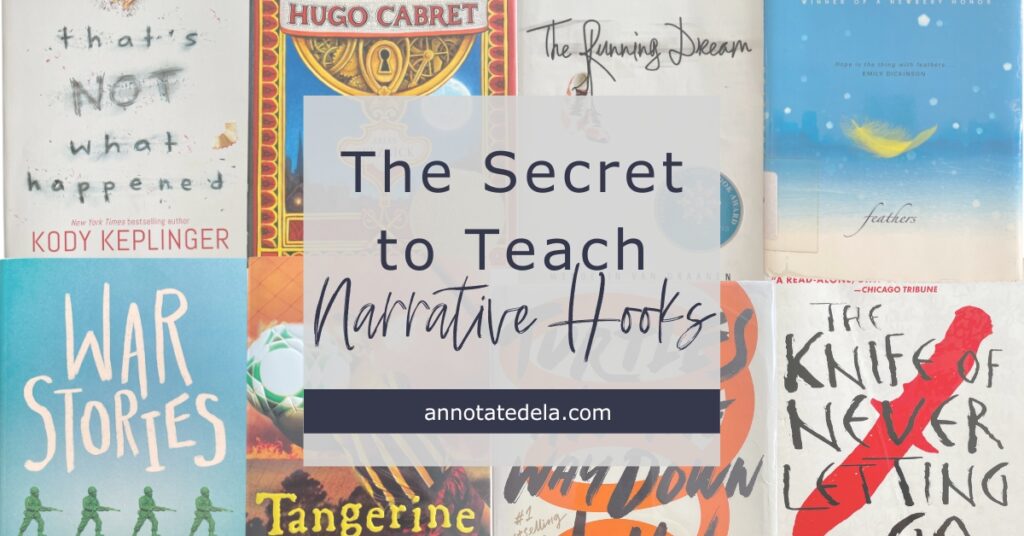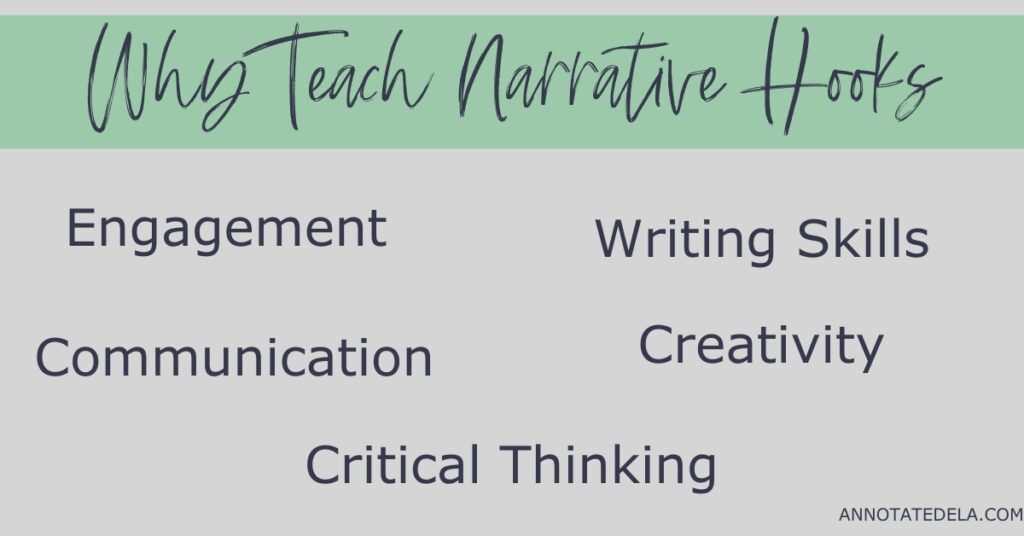
Novels and mentor texts are powerful tools to teach hooks in narrative writing.
Crafting an engaging hook isn’t just about reeling in the reader; it’s about enhancing student engagement, honing effective communication skills, sparking creativity, and fostering critical thinking.
Trust me, it’s the bait that keeps on giving in the realm of writing skills across various genres. 👈🏼This line might be more proof as to why I am often awarded hall goofball by my colleagues!
Let’s explore why we should spend time teaching hooks and why mentor texts are the secret ingredient – let’s reel in and teach hooks in narrative writing together.
If you are looking for a lesson to teach hooks in narrative writing, check out Narrative Writing Hooks.
Why Teach Hooks in Narrative Writing?

Engagement
In a classroom setting, students who can craft engaging hooks in their writing are more likely to hold their readers’ interest and produce quality writing.
Adding a more authentic audience steps up the rigor and motivation. Invite administrators, other teachers, instructional coaches, and other students to the audience list. When students know that they are producing for a larger audience, many will put forth extra effort.
I don’t know about you, but I definitely prefer that students write something I enjoy reading too.
Effective Communication
Learning to write a strong hook encourages students to think critically about how they introduce their ideas. This can translate to other genres of writing.
Writing the hooks after students have had a chance to plan the narrative or write the narrative encourages a more thoughtful hook. Students know where the story is going, so to speak and can craft a hook that is thoughtful and meaningful to the narrative.
It also teaches them to communicate effectively, ensuring that their message is clear and impactful.
Creativity and Critical Thinking
Crafting hooks requires creativity and critical thinking. It encourages students to think outside the box and consider various approaches to engage their audience, fostering their imaginative skills.
While also asking them to think about the narrative as a whole. The students must take the whole and then break into a part that fits perfectly.
Building Writing Skills
Understanding how to construct a good hook is fundamental to writing across various genres and forms. It lays the groundwork for developing strong writing skills applicable to narratives, essays, persuasive pieces, and more.
Why Use Novels as Mentor Text to Teach Hooks in Narrative Writing?

Using mentor text can be invaluable tools for teaching students about hooks for several reasons.
Mentor texts provide clear examples
These books provide clear examples of engaging hooks. Analyzing the opening lines or chapters can help students understand different techniques authors use to captivate readers.
Different Approaches
Each book uses a unique hook in narrative writing— for types of hooks check out my blog post Hooks in Narrative Writing and the 6 Types of Hooks to Engage Readers.
If you are looking for activities to teach hooks in narrative writing, listen to episode 35: 5 Five Simple Activities for Teaching Students to Write Narrative Hooks at annotatedela.com/episode35.
This variety allows teachers to showcase different approaches to hook readers’ attention.
And students are exposed to authentic writing outside the walls of the classroom.
With that being said, having students share their hooks can be just as effective and powerful to teach hooks in narrative writing.
Discussion and Analysis
Teachers can facilitate discussions about why the hooks in the books are effective. Encouraging students to analyze the hooks in these novels can help them identify what elements make a strong hook and apply these techniques in their writing.
Set up stations with different genres of books at each station and ask students to:
Identify type of hook
Is it effective or not? Why?
After visiting each station, ask students to think-pair-share about the hooks they discovered at each station and if they noticed any patterns among genres? Were certain types of hooks used more often within a genre or no pattern.
Have students reflect on what they learned about hooks.
Inspiration and Practice
Mentor text can inspire students to create their hooks.
It can serve as a springboard for their own writing exercises where they attempt to craft hooks that emulate the style or capture the essence of the books they’ve read.
It can be beneficial to keep a chart or a tracker for good hooks that students can reference as they write. There are several ways to do this.
Students can track the hooks themselves in their notebooks, with the hook quoted, the title of the book and the author.
Possible Book Suggestions to Teach Hooks in Narrative Writing:
Descriptive Hook
The Graveyard Book by Neil Gaiman
“There was a hand in the darkness, and it held a knife.”
Holes by Louis Sachar
“There is no lake at Camp Green Lake.”
The City of Ember by Jeanne DuPrau
“Many hundreds of years ago, the city of Ember was created by the Builders to contain everything needed for human survival.”
Sound Effect Hook
The Knife of Never Letting Go by Patrick Ness
“The first thing you find out when yer dog learns to talk is that dogs don’t got nothing much to say.”
The Westing Game by Ellen Raskin
“The sun sets in the west (just about everyone knows that), but Sunset Towers faced east.”
The Hunger Games by Suzanne Collins
“When I wake up, the other side of the bed is cold.”
Character Hook
Percy Jackson and the Olympians: The Lightning Thief by Rick Riordan
“Look, I didn’t want to be a half-blood.”
Refugee by Alan Gratz
“The Nazis had already taken my mother and father. I was the only one left.”
The One and Only Ivan by Katherine Applegate
“I am Ivan. I am a gorilla. It’s not as easy as it looks.”
Dialogue Hook
A Series of Unfortunate Events: The Bad Beginning by Lemony Snicket
“If you are interested in stories with happy endings, you would be better off reading some other book.”
Bridge to Terabithia by Katherine Paterson
“He’s the strangest kid I ever met,’ she said.”
The Outsiders by S.E. Hinton
“‘When I stepped out into the bright sunlight from the darkness of the movie house, I had only two things on my mind: Paul Newman and a ride home.'”
Interesting Comment Hook
The Golden Compass by Philip Pullman
“Lyra and her daemon moved through the darkening hall, taking care to keep to one side, out of sight of the kitchen.”
The Lightning Thief by Rick Riordan
“Look, I didn’t want to be a half-blood.”
The Graveyard Book by Neil Gaiman
“There was a hand in the darkness, and it held a knife.”
Action Hook
Eragon by Christopher Paolini
“Wind howled through the night, carrying a scent that would change the world.”
The Maze Runner by James Dashner
“He began his new life standing up, surrounded by cold darkness and stale, dusty air.”
The Giver by Lois Lowry
“It was almost December, and Jonas was beginning to be frightened.”
There are so many books, every book uses a hook, so use what you have. While I know there are more relevant and current books, I chose some of these books because my students have been talking about the movies or seem to be newly interested in these titles in the classroom.
Related Articles to Teach Hooks in Narrative Writing
Hooks in Narrative Writing and 6 Types of Hooks to Engage Readers
5 Simple Ways to Teach Narrative Hooks in Middle School
Books with Good Hooks for Teaching Powerful Leads to Middle School
Resources to Teach Hooks in Narrative Writing







